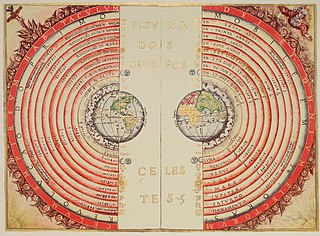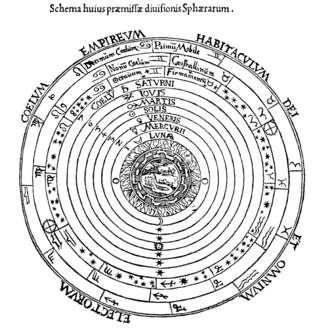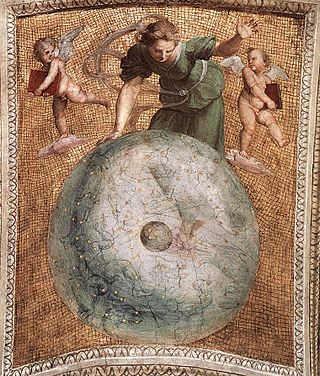Related Research Articles
Air or Wind is one of the four classical elements along with water, earth and fire in ancient Greek philosophy and in Western alchemy.

The cosmos is an alternative name for the universe or its nature or order. Usage of the word cosmos implies viewing the universe as a complex and orderly system or entity. The cosmos, and understandings of the reasons for its existence and significance, are studied in cosmology – a broad discipline covering scientific, religious or philosophical aspects of the cosmos and its nature. Religious and philosophical approaches may include the cosmos among spiritual entities or other matters deemed to exist outside the physical universe.

In astronomy and navigation, the celestial sphere is an abstract sphere that has an arbitrarily large radius and is concentric to Earth. All objects in the sky can be conceived as being projected upon the inner surface of the celestial sphere, which may be centered on Earth or the observer. If centered on the observer, half of the sphere would resemble a hemispherical screen over the observing location.
Simplicius of Cilicia was a disciple of Ammonius Hermiae and Damascius, and was one of the last of the Neoplatonists. He was among the pagan philosophers persecuted by Justinian in the early 6th century, and was forced for a time to seek refuge in the Persian court, before being allowed back into the empire. He wrote extensively on the works of Aristotle. Although his writings are all commentaries on Aristotle and other authors, rather than original compositions, his intelligent and prodigious learning makes him the last great philosopher of pagan antiquity. His works have preserved much information about earlier philosophers which would have otherwise been lost.

In astronomy, the geocentric model is a superseded description of the Universe with Earth at the center. Under most geocentric models, the Sun, Moon, stars, and planets all orbit Earth. The geocentric model was the predominant description of the cosmos in many European ancient civilizations, such as those of Aristotle in Classical Greece and Ptolemy in Roman Egypt, as well as during the Islamic Golden Age.
The cosmological model of concentricspheres, developed by Eudoxus, Callippus, and Aristotle, employed celestial spheres all centered on the Earth. In this respect, it differed from the epicyclic and eccentric models with multiple centers, which were used by Ptolemy and other mathematical astronomers until the time of Copernicus.

The celestial spheres, or celestial orbs, were the fundamental entities of the cosmological models developed by Plato, Eudoxus, Aristotle, Ptolemy, Copernicus, and others. In these celestial models, the apparent motions of the fixed stars and planets are accounted for by treating them as embedded in rotating spheres made of an aetherial, transparent fifth element (quintessence), like gems set in orbs. Since it was believed that the fixed stars did not change their positions relative to one another, it was argued that they must be on the surface of a single starry sphere.

In astronomy, the fixed stars are the luminary points, mainly stars, that appear not to move relative to one another against the darkness of the night sky in the background. This is in contrast to those lights visible to naked eye, namely planets and comets, that appear to move slowly among those "fixed" stars.

On the Heavens is Aristotle's chief cosmological treatise: written in 350 BC, it contains his astronomical theory and his ideas on the concrete workings of the terrestrial world. It should not be confused with the spurious work On the Universe.

The Copernican Revolution was the paradigm shift from the Ptolemaic model of the heavens, which described the cosmos as having Earth stationary at the center of the universe, to the heliocentric model with the Sun at the center of the Solar System. This revolution consisted of two phases; the first being extremely mathematical in nature and the second phase starting in 1610 with the publication of a pamphlet by Galileo. Beginning with the 1543 publication of Nicolaus Copernicus’s De revolutionibus orbium coelestium, contributions to the “revolution” continued until finally ending with Isaac Newton’s work over a century later.

The unmoved mover or prime mover is a concept advanced by Aristotle as a primary cause or "mover" of all the motion in the universe. As is implicit in the name, the unmoved mover moves other things, but is not itself moved by any prior action. In Book 12 of his Metaphysics, Aristotle describes the unmoved mover as being perfectly beautiful, indivisible, and contemplating only the perfect contemplation: self-contemplation. He equates this concept also with the active intellect. This Aristotelian concept had its roots in cosmological speculations of the earliest Greek pre-Socratic philosophers and became highly influential and widely drawn upon in medieval philosophy and theology. St. Thomas Aquinas, for example, elaborated on the unmoved mover in the Quinque viae.

Ancient Greek astronomy is the astronomy written in the Greek language during classical antiquity. Greek astronomy is understood to include the Ancient Greek, Hellenistic, Greco-Roman, and late antique eras. Ancient Greek astronomy can be divided into three primary phases: Classical Greek Astronomy, which encompassed the 5th and 4th centuries BC, and Hellenistic Astronomy, which encompasses the subsequent period until the formation of the Roman Empire ca. 30 BC, and finally Greco-Roman astronomy, which refers to the continuation of the tradition of Greek astronomy in the Roman world. During the Hellenistic era and onwards, Greek astronomy expanded beyond the geographic region of Greece as the Greek language had become the language of scholarship throughout the Hellenistic world, in large part delimited by the boundaries of the Macedonian Empire established by Alexander the Great. The most prominent and influential practitioner of Greek astronomy was Ptolemy, whose treatise Almagest shaped astronomical thinking until the modern era. Most of the most prominent constellations known today are taken from Greek astronomy, albeit via the terminology they took on in Latin.

In classical, medieval, and Renaissance astronomy, the Primum Mobile was the outermost moving sphere in the geocentric model of the universe.
Islamic cosmology is the cosmology of Islamic societies. It is mainly derived from the Qur'an, Hadith, Sunnah, and current Islamic as well as other pre-Islamic sources. The Qur'an itself mentions seven heavens.

Copernican heliocentrism is the astronomical model developed by Nicolaus Copernicus and published in 1543. This model positioned the Sun at the center of the Universe, motionless, with Earth and the other planets orbiting around it in circular paths, modified by epicycles, and at uniform speeds. The Copernican model displaced the geocentric model of Ptolemy that had prevailed for centuries, which had placed Earth at the center of the Universe.
Aristotelian physics is the form of natural philosophy described in the works of the Greek philosopher Aristotle. In his work Physics, Aristotle intended to establish general principles of change that govern all natural bodies, both living and inanimate, celestial and terrestrial – including all motion, quantitative change, qualitative change, and substantial change. To Aristotle, 'physics' was a broad field including subjects which would now be called the philosophy of mind, sensory experience, memory, anatomy and biology. It constitutes the foundation of the thought underlying many of his works.

Ancient, medieval and Renaissance astronomers and philosophers developed many different theories about the dynamics of the celestial spheres. They explained the motions of the various nested spheres in terms of the materials of which they were made, external movers such as celestial intelligences, and internal movers such as motive souls or impressed forces. Most of these models were qualitative, although a few of them incorporated quantitative analyses that related speed, motive force and resistance.
Sphere of fire is the name given in Ptolemaic astronomy to the sphere intervening between, and separating, the Earth and the Moon.
Jacques du Chevreul was a French mathematician, astronomer, and philosopher.

Historical models of the Solar System began during prehistoric periods and are updated to this day. The models of the Solar System throughout history were first represented in the early form of cave markings and drawings, calendars and astronomical symbols. Then books and written records became the main source of information that expressed the way the people of the time thought of the Solar System.
References
- ↑ Aristotle, Ethics (1974) p. 357-8
- ↑ Stephen Toulmin, Night Sky at Rhodes (1963) p. 38 and p. 78
- ↑ C. C. Gillespie, The Edge of Objectivity (1960) p. 14
- ↑ Gillespie, p. 13-5
- ↑ J. J. E. Garcia, Individuation in Scholasticism (1994) p. 41
- ↑ W. Hooper, C. S. Lewis (1996) p. 529-31
- ↑ R. Curley, Scientists and Inventors of the Renaissance (2012) p. 6-8
- ↑ Thomas S. Kuhn, The Structure of Scientific Revolutions (1970) p. 116-7
- ↑ Dante, Purgatory (1971) p. 235
- ↑ Samuel Johnson, Selected Writings (Penguin) p. 266